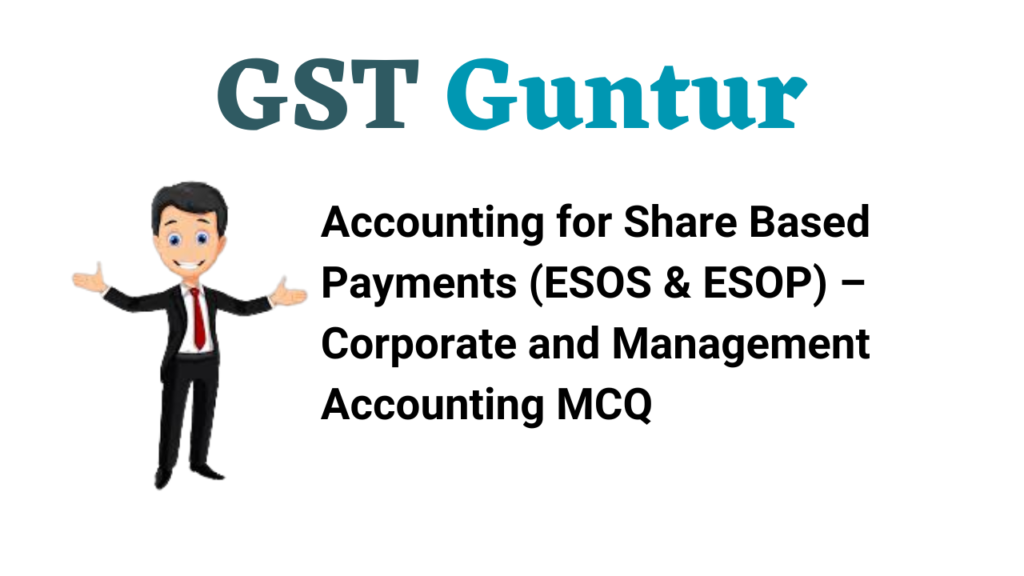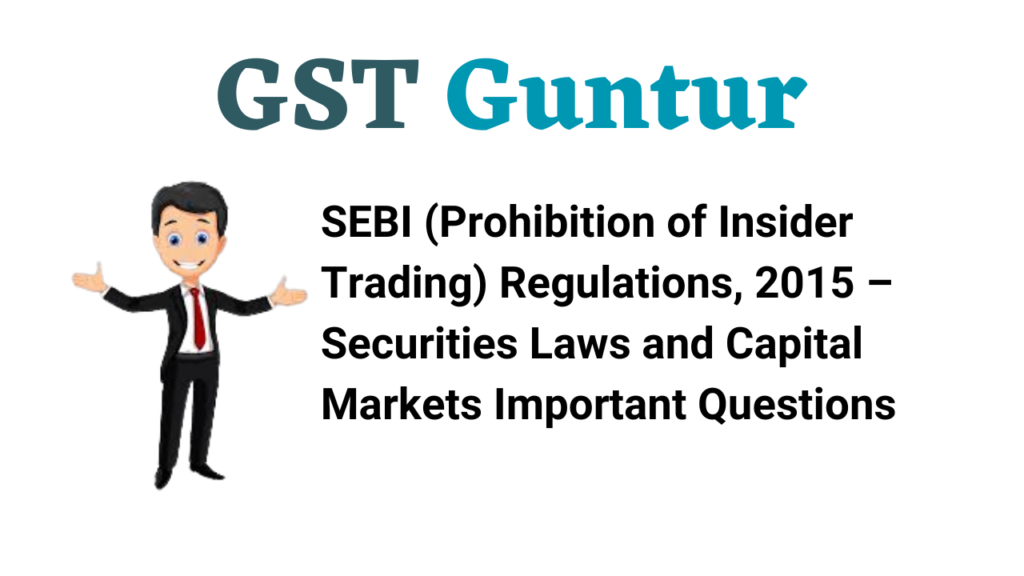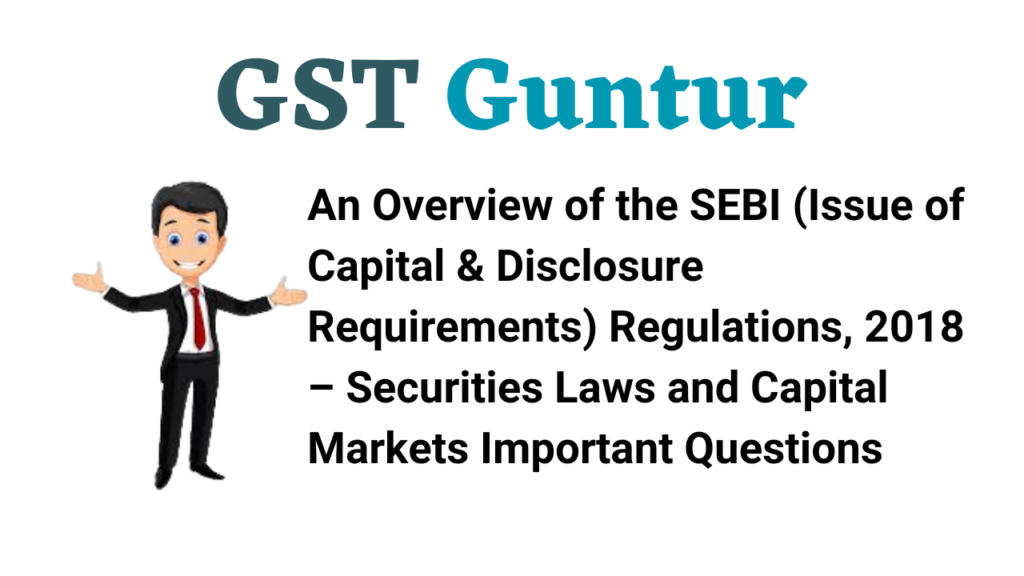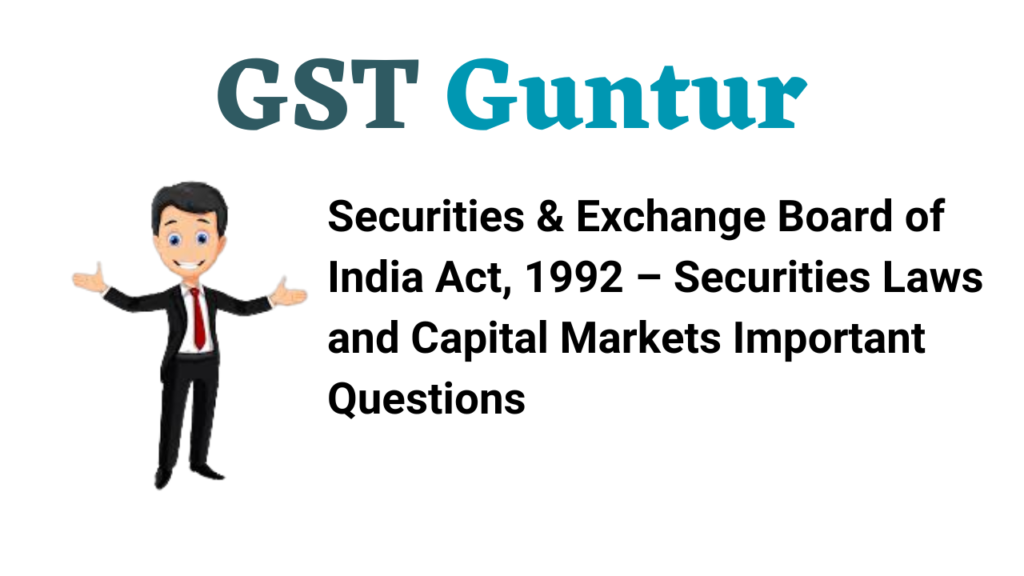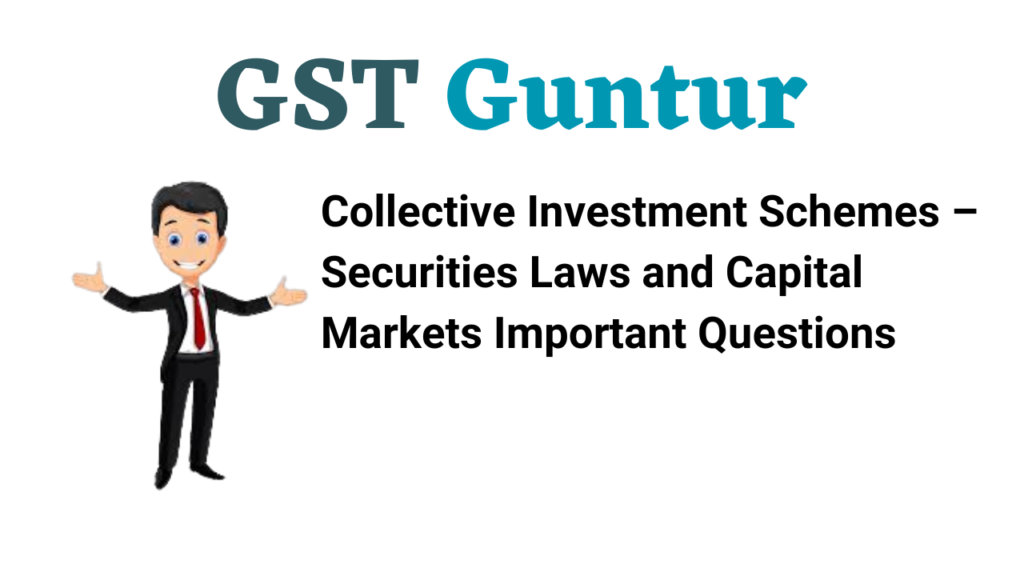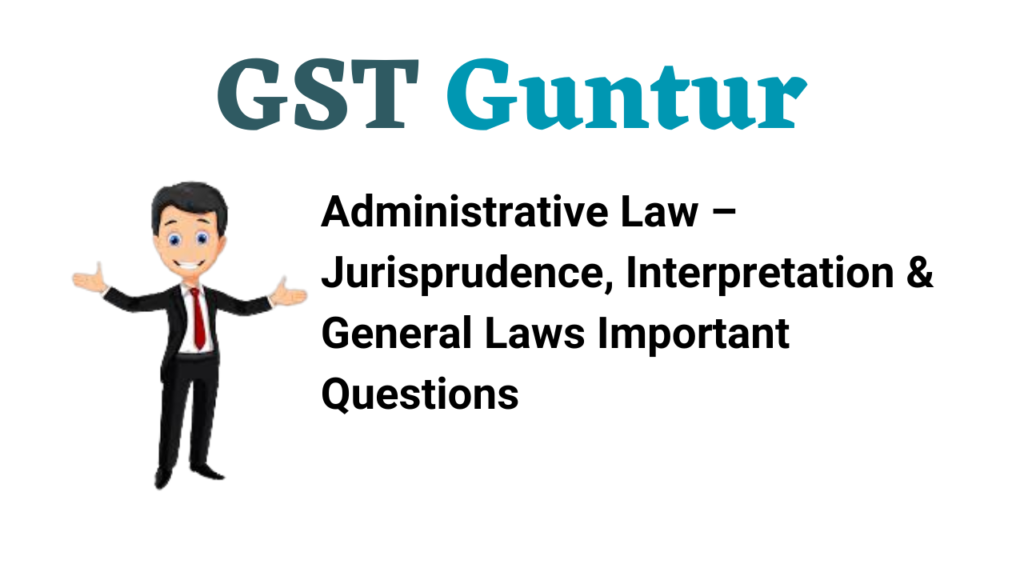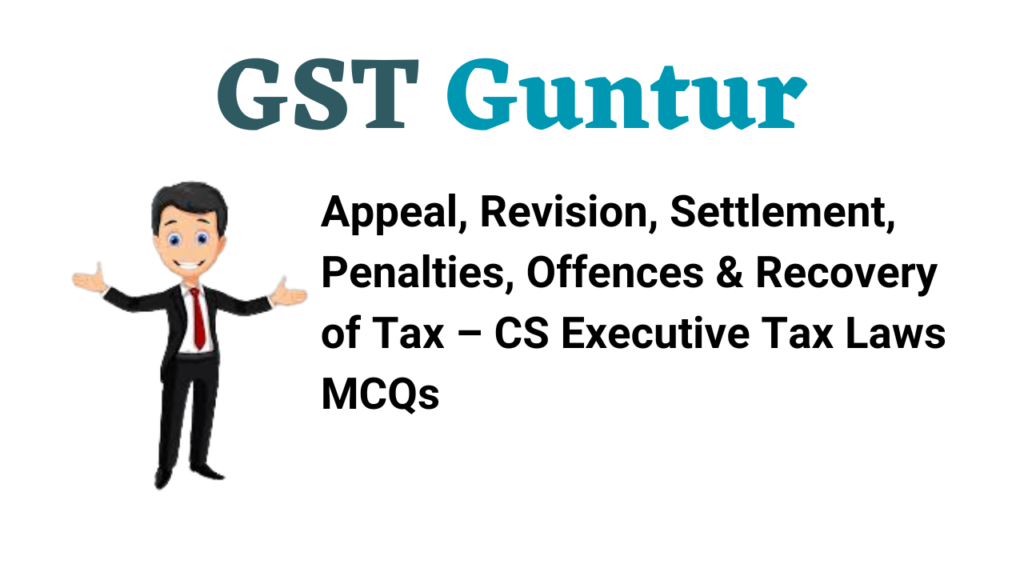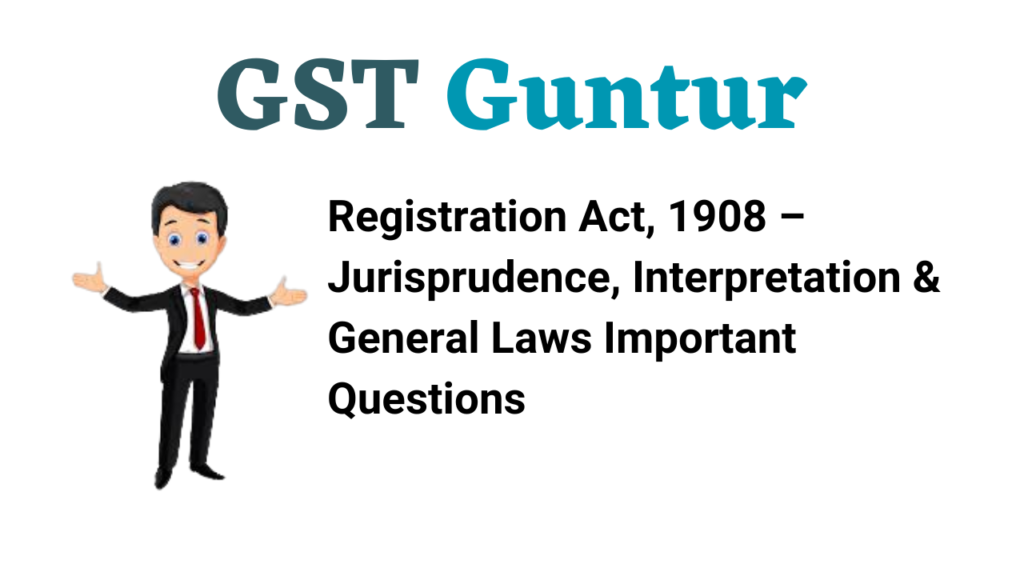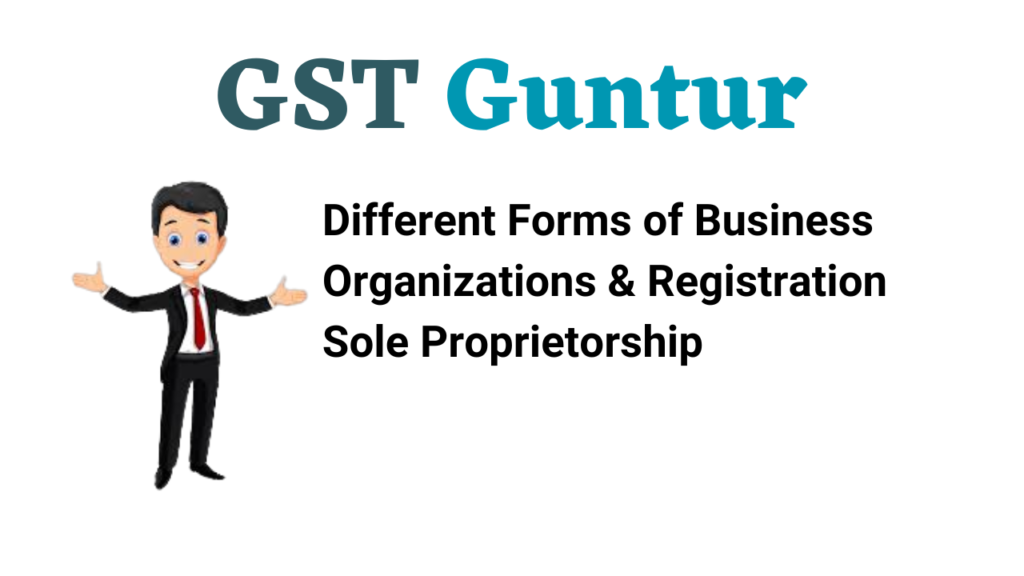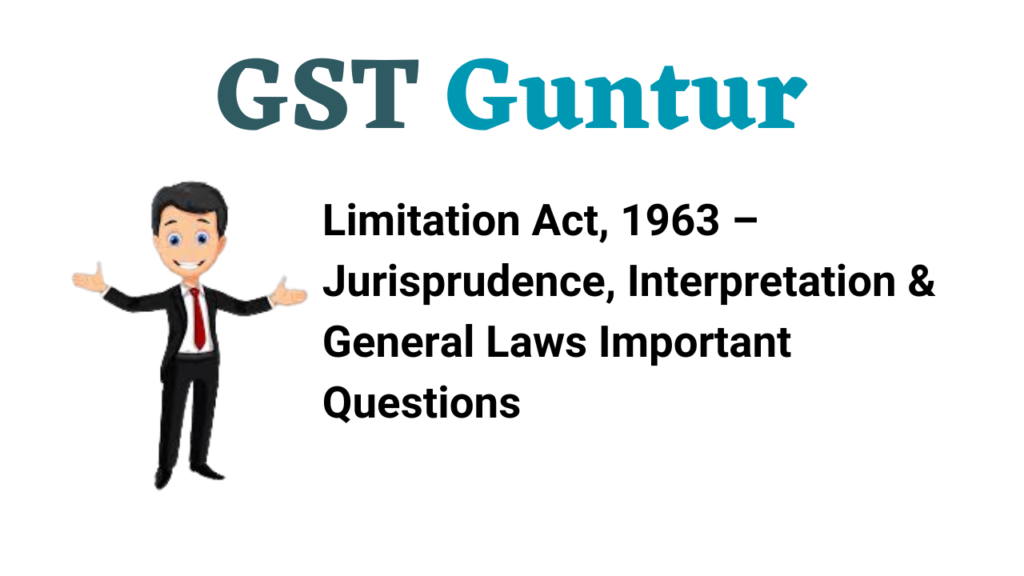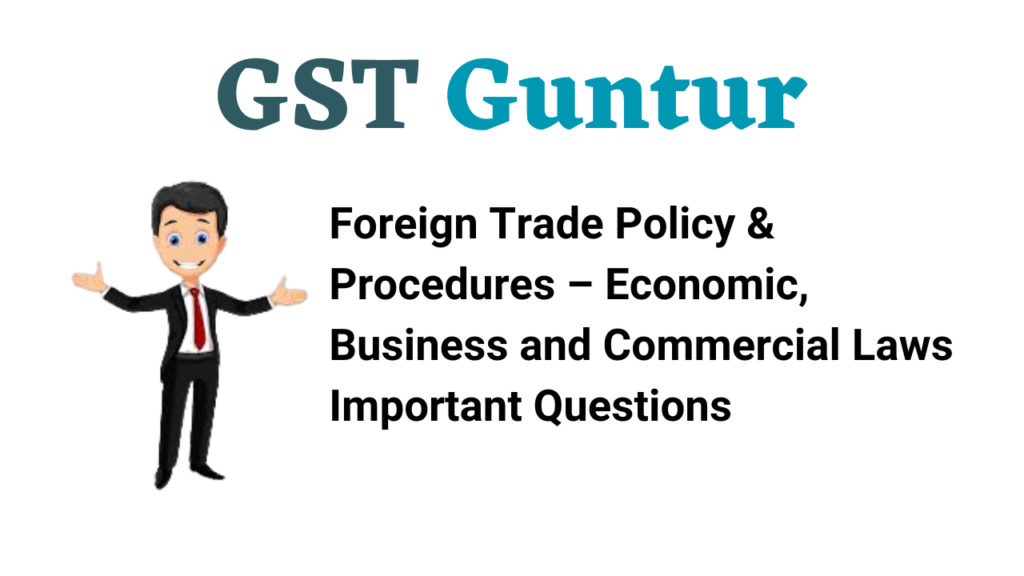SEBI (Prohibition of Insider Trading) Regulations, 2015 – Securities Laws and Capital Markets Important Questions
Question 1.
Explain the disclosure requirements by certain persons under the SEBI (Prohibition of Insider Trading) Regulations, 2015. [June 2009 (4 Marks)]
Answer:
Disclosures by certain persons [Regulation 7]:
Initial Disclosures:
(a) Every promoter, member of the promoter group, KMP, and director of the listed company shall disclose his holding of securities to the company within 30 days of these regulations taking effect.
(b) Every person on appointment as KMP or a director of the company or upon becoming a promoter or member of promoter group shall disclose his holding of securities of the company within 7 days of his appointment as KMP, director or becoming a promoter.
Continual Disclosures:
(a) Every promoter, member of the promoter group, designated person, and director of every company shall disclose to the company the number of securities acquired or disposed of within 2 trading days if the value of the securities traded over any calendar quarter exceeds ₹ 10 lakhs or such other value as may be specified.
(b) On receipt of the above information, the company shall notify the same to the stock exchange within 2 trading days of receipt information or from becoming aware of such information.
(c) The above disclosures shall be made in such form and such manner as may be specified by the SEBI from time to time.
Disclosures by other connected persons:
A listed company may at its discretion require any other connected person to make disclosures of holdings and trading in securities in such form and at such frequency as may be determined by the company in order to monitor compliance.
Question 2.
Distinguish between: ‘Insider’ and ‘connected persons’ as per the SEBI (Prohibition of Insider Trading) Regulations, 2015. [Dec. 2010 (5 Marks)]
Answer:
Insider [Regulation 2(g)]: Insider means any person who is:
- a connected person or
- In possession of or having access to unpublished price sensitive information;
Connected Person [Regulation 2(d)]: Connected person means
1. Any person who is or has during the 6 months prior to the concerned act been associated with a company, directly or indirectly, in any capacity including by reason of frequent communication with its officers or by being in any contractual, fiduciary, or employment relationship or by being a director, officer or an employee of the company or holds any position including a professional or business relationship between himself and the company whether temporary or permanent, that allows such person, directly or indirectly, access to unpublished price sensitive information or is reasonably expected to allow such access.
2. Following categories shall be deemed to be connected persons unless the contrary is established:
(a) An immediate relative of connected persons specified in clause (i)
or
(b) A holding company or associate company or subsidiary company
or
(c) An intermediary as specified in Section 12 of the SEBI Act, 1992 or an employee or director thereof
or
(d) An investment company, trustee company, AMC, or an employee or director thereof
or
(e) An official of a stock exchange or of clearing house or corporation
or
(f) A member of the board of trustees of a mutual fund or a member of the board of directors of the AMC of a mutual fund or is an employee thereof
or
(g) A member of the board of directors or an employee, of a public financial institution
or
(h) An official or an employee of a self-regulatory organization recognized
or
(i) A banker of the company
or
(j) A concern, firm, trust, HUF, company, or AOP wherein a director of a company or his immediate relative or banker of the company, has more than 10% of the holding or interest.
Question 3.
Write a short note on Chinese Wall Policy [June 2011 (4 Marks)]
Answer:
A ‘Chinese Wall’ means an arrangement where information known to the person in one part of the business is not available directly or indirectly to those in another part of the business.
To prevent the misuse of confidential information the organization shall adopt a “Chinese Wall Policy” which separates those areas of the organization that routinely have access to confidential information, from those areas which deal with sale/marketing/investment advice or other departments providing support services. The employees in the respective areas shall not communicate any price-sensitive information to the other areas.
Question 4.
What is meant by “unpublished price sensitive information”? What are the restrictions on communication or procurement of unpublished price-sensitive information? [Dec. 2011 (4 Marks)]
Answer:
Unpublished price sensitive information means any information, relating to a company or its securities, directly or indirectly, that is not generally available and which upon becoming generally available, is likely to materially affect the price of the securities and ordinarily includes information relating to the following:
(a) Financial results
(b) Dividends
(c) Change in capital structure
(d) Mergers, dc-mergers, acquisitions, de-listings, disposals and expansion of business and such other transactions
(e) Changes in KMP
(f) Material events in accordance with the listing agreement. [Deleted]
Communication or procurement of unpublished price sensitive information [Regulation 3]:
1. No insider shall communicate, provide, or allow access to any unpublished price sensitive information, relating to a company or securities listed or proposed to be listed, to any person including other insiders except where such communication is in furtherance of legitimate purposes, the performance of duties or discharge of legal obligations.
2. No person shall procure from or cause the communication by any insider of unpublished price sensitive information, relating to a company or securities listed or proposed to be listed, except in furtherance of legitimate purposes, the performance of duties, or discharge of legal obligations.
3. The board of directors of a listed company shall make a policy for the determination of “legitimate purposes as a part of “Codes of Fair Disclosure and Conduct” formulated under regulation 8.
Explanation: The term “legitimate purpose” shall include sharing of unpublished price sensitive information in the ordinary course of business an insider with partners, collaborators, lenders, customers, suppliers, merchant bankers, legal advisors, auditors, insolvency professionals, or other advisors or consultants, provided that such sharing has not been carried out to evade or circumvent the prohibitions of these regulations.
4. Any person in receipt of unpublished price sensitive information pursuant to a legitimate purpose” shall be considered an “insider” for purposes of these regulations and due notice shall be given to such persons to maintain the confidentiality of such unpublished price sensitive information in compliance with these regulations.
5. An unpublished price sensitive information may be communicated, provided, allowed access to or procured, in connection with a transaction that would:
1. entail an obligation to make an open offer under the takeover regulations where the board of directors of the listed company is of informed opinion that sharing of such information is in the best interests of the company;
2. not attract the obligation to make an open offer under the takeover regulations but where the board of directors of the listed company is of informed opinion that sharing of such information is in the best interests of the company and the information that constitute unpublished price sensitive information is disseminated to be made generally available at least 2 trading days prior to the proposed transaction being effected in such form as the board of directors may determine to be adequate and fair to cover all relevant and material facts.
6. The board of directors shall require the parties to execute agreements to contract confidentiality and non-disclosure obligations on the part of such parties and such parties shall keep information so received confidential and shall not otherwise trade in securities of the company when in possession of unpublished price sensitive information.
7. The board of directors or heads of the organization of every person required to handle unpublished price sensitive information shall ensure that a structured digital database is maintained containing the nature of unpublished price sensitive information and the names of such persons who have shared the information and also the names of such persons with whom information is shared under this regulation along with the Permanent Account Number or any other identifier authorized by law where Permanent Account Number is not available. Such database shall not be outsourced and shall be maintained internally with adequate internal controls and checks such as time stamping and audit trails to ensure non-tampering of the database.
8. The board of directors or heads of the organization of every person required to handle unpublished price sensitive information shall ensure that the structured digital database is preserved for a period of not less than eight years after completion of the relevant transactions and in the event of receipt of any information from the SEBI regarding any investigation or enforcement proceedings, the relevant information in the structured digital database shall be preserved till the completion of such proceedings.
Question 5.
What do you mean by insider trading? Enumerate the penalties which can be imposed under the SEBI Act, 1992 for insider trading? [June 2013 (4 Marks)]
Answer:
Insider shall not communicate, provide or allow access to any unpublished price-sensitive information relating to the company or its securities to any person.
In the given case, Raghav has found to be indulging in insider trading, which is prohibited under the SEBI (Prohibition of Insider Trading) Regulations, 2015.
Insider trading is punishable u/s 15G of the SEBI Act, 1992. The penalty is as follows:
An insider shall be liable to a penalty which shall not be less than ? 10 lakhs but which may extend to ^ 25 Crores or 3 times of profits out of insider trading, whichever is higher.
Taking action by the company does not preclude the SEBI from taking any action under the SEBI Act, 1992. Hence, Raghav’s plea that he had already penalized by the company by terminating his services is not acceptable.
Question 6.
Insider trading normally means trading in shares of a company by the persons who are in the management of the company or close to them on the basis of unpublished price-sensitive information which they possess but others not.
In the light of this, state whether the following information is price sensitive:
(i) The CEO of a company met with an accident and had been hospitalized.
(ii) Intended declaration of rights issue in near future.
(iii) RBI has increased repo rate by 25 basis points.
(iv) The company is going to have another plant at Rudrapur, Uttarakhand.
(v) The Chairman of the company has submitted his resignation to the Board under protest for selling a particular brand to another company. [Dec. 2013(4 Marks)]
Answer:
Unpublished price sensitive information means any information, relating to a company or its securities, directly or indirectly, that is not generally j available and which upon becoming generally available, is likely to materially 1 affect the price of the securities.
In view of the above, the answer to the given problem is as follows:
| Information |
Price sensitive or not |
Reason |
| The CEO of a company died in an air crash. |
No |
Though information relates to the company, it is not relating to security or its price, or any other parameters included in the definition. |
| RBI has increased the report by 25 basis points. |
No |
This information is not related to the company, its security, or price of security hence it is not ‘unpublished price sensitive information. In fact, it is information relating to the general economy of the country. |
| The company is setting up another plant in Gujarat |
Yes |
Information relating to the expansion of business is included in the definition of ‘unpublished price sensitive information. |
| The company is negotiating with a foreign company to sell its stake in Star Ltd. |
Yes |
This information relates to the investment strategy of the company and may likely affect the price of its security and hence included in the definition. |
Question 7.
Write a short note on Unpublished price sensitive information [June 2014 (4 Marks)]
Answer:
Unpublished price sensitive information means any information, relating to a company or its securities, directly or indirectly, that is not generally available and which upon becoming generally available, is likely to materially affect the price of the securities and ordinarily includes information relating to the following:
(a) Financial results
(b) Dividends
(c) Change in capital structure
(d) Mergers, de-mergers, acquisitions, de-listings, disposals and expansion of business and such other transactions
(e) Changes in KMP and
(f) Material events in accordance with the listing agreement. [Deleted]
Question 8.
Raghav, General Manager (Accounts) of X Ltd., was found to be indulging in insider trading and as a consequence, the company terminated his services. The SEBI also took cognizance of the matter and initiated proceedings against him under the SEBI (Prohibition of Insider Trading) Regulations, 2015. Raghav pleaded that since X Ltd. had already penalized him by terminating his services, the SEBI could not initiate any proceedings against him. As per the SEBI Regulations and decided case laws, suggest whether the SEBI has a right to take any action against Raghav in this case of insider trading. [June 2014 (8 Marks)]
Answer:
Insider shall not communicate, provide or allow access to any unpublished price-sensitive information relating to the company or its securities to any person.
In the given case, Raghav has found to be indulging in insider trading, which is prohibited under the SEBI (Prohibition of Insider Trading) Regulations, 2015.
Insider trading is punishable u/s 15G of the SEBI Act, 1992. The penalty is as follows:
An insider shall be liable to a penalty which shall not be less than ? 10 lakhs but which may extend to ^ 25 Crores or 3 times of profits out of insider trading, whichever is higher.
Taking action by the company does not preclude the SEBI from taking any action under the SEBI Act, 1992. Hence, Raghav’s plea that he had already penalized by the company by terminating his services is not acceptable.
Question 9.
A company shall specify a trading period for trading in its own securities. Comment. [Dec. 2014 (4 Marks)]
Answer:
Trading when in possession of unpublished price sensitive information [Regulation 4]:
1. Insider shall not trade in securities that are listed or proposed to be listed on a stock exchange when in possession of unpublished price-sensitive information.
Explanation: When a person who has traded in securities has been in possession of unpublished price-sensitive information, his trades would be presumed to have been motivated by the knowledge and awareness of such information in his possession.
However, the insider may prove his innocence by demonstrating the circumstances including the following:
1. The transaction is an off-market inter .se transfer between insiders who were in possession of the same unpublished price sensitive information without being in breach of Regulation 3 and both parties had made a conscious and informed trade decision. Such unpublished price-sensitive information was not obtained under regulation 3(3). Such off-market trades shall be reported by the insiders to the company within 2 working days. Every company shall notify the particulars of such trades to the stock exchange on which the securities are listed within 2 trading days from receipt of the disclosure or from becoming aware of such information.
2. The transaction was carried out through the block deal window mechanism between persons who were in possession of the unpublished price-sensitive information without being in breach of Regulation 3 and both parties had made a conscious and informed trade decision. Such unpublished price-sensitive information was not obtained by either person Regulation 3(3).
3. The transaction in question was carried out pursuant to a statutory or regulatory obligation to carry out a bona fide transaction.
4. The transaction in question was undertaken pursuant to the exercise of stock options in respect of which the exercise price was pre-determined in compliance with applicable regulations.
5. In the case of non-individual insiders:
(a) the individuals who were in possession of such unpublished price sensitive information were different from the individuals taking trading decisions and such decision-making individuals were not in possession of such unpublished price sensitive information when they took the decision to trade; and
(b) appropriate and adequate arrangements were in place to ensure that these regulations are not violated and no unpublished price sensitive information was communicated by the individuals possessing the information to the individuals taking trading decisions and there is no evidence of such arrangements having been breached;
6. The trades were pursuant to a trading plan set up in accordance with Regulation 5.
2. In the case of connected persons the onus of establishing, that they were not in possession of unpublished price-sensitive information, shall be on such connected persons, and in other cases, the onus would be on the SEBI.
3. The SEBI may specify such standards and requirements, from time to time, as it may deem necessary for the purpose of these regulations.
Trading Plans [Regulation 5]:
1. An insider shall be entitled to formulate a trading plan and present it to the compliance officer for approval and public disclosure pursuant to which trades may be carried out on his behalf in accordance with such plan.
2. A trading plan formulated by an insider is subject to the following conditions:
- Trading as per the trading plan can be commenced after 6 months from the date of public disclosure of such trading plan.
- Trading as per the trading plan cannot be executed 20th trading day prior to the last day of any financial period and the second trading day after the disclosure of such financial results. (logic is that 20th day earlier to close of the financial period the company has to announce financial results)
- A trading plan should not be less than 12 months.
- Two trading plans should not overlap each other. (In other words, the second trading plan cannot be made unless the first trading plan ends)
- Such a trading plan shall set out either the value of trades to be affected or the number of securities to be traded along with the nature of the trade and the intervals at, or dates on which such trades shall be effected.
- A trading plan shall not be used for trading in securities for market abuse.
3. The compliance officer shall review the trading plan to assess whether the plan would have any potential for violation of these regulations and shall be entitled to seek such express undertakings as may be necessary to enable such assessment and to approve and monitor the implementation of the plan. However, pre-clearance of trades shall not be required for a trade executed as per an approved trading plan. It is also provided that trading window norms and restrictions on contra trade shall not be applicable for trades carried out in accordance with an approved trading plan.
4. The trading plan once approved shall be irrevocable and the insider shall mandatorily have to implement the plan, without being entitled to either deviate from it or to execute any trade in the securities outside the scope of the trading plan. However, the implementation of the trading plan shall not be commenced if any unpublished price sensitive information in possession of the insider at the time of formulation of the plan has not become generally available at the time of the commencement of implementation and in such event, the compliance officer shall confirm that the commencement ought to be deferred until such unpublished price sensitive information becomes generally available information so as to avoid a violation of Regulation 4(1).
5. Upon approval of the trading plan, the compliance officer shall notify the plan to the stock exchanges on which the securities are listed.
Question 10.
Sunil, Company Secretary and Executive Director of a company had bought shares of that company on behalf of his family members on the basis of unpublished price sensitive information, which was not known to the general public but to him as an employee of the company.
Family members, later on, tendered the said shares in an open offer announced by some acquiring company at a higher price, thereby making huge gains. The SEBI found Sunil guilty of misconduct of insider trading and imposed a penalty. Sunil admitted that he had made a mistake but contested the penalty. He, however, was willing to pay back the profit earned by the sale of shares.
Considering the facts of the case, you are required to suggest whether as per j the relevant legal provisions relating to insider trading, the SEBI should waive the penalty considering the fact that Sunil admits indulging in insider trading and is willing to pay back the whole profit earned. [Dec. 2014 (8 Marks)]
Answer:
Insider trading is punishable u/s 15G of the SEBI Act, 1992. The penalty is as follows:
An insider shall be liable to a penalty which shall not be less than ₹ 10 lakhs but which may extend to f 25 Crores or 3 times of profits out of insider trading, whichever is higher.
In the given case, Sunil being the Company Secretary and Executive Director of a company is an insider and has committed the offense of insider trading. Thus, SEBI can impose a penalty on him as per Section 15G of the SEBI Act, 1992.
The Supreme Court in the matter of SEBI v. Sriram Mutual Fund had held that “once the violation of statutory regulation is established, imposition of penalty becomes the sine qua non of violation and intention of parties committing violation totally becomes irrelevant”.
However, in given since Mr. Sunil has admitted his offense and has offered to pay back profit so penalty to that extend may be reduced.
Question 11.
Unpublished price-sensitive information is any information that relates directly or indirectly to a company. [June 2015 (4 Marks)]
Answer:
Unpublished price sensitive information means any information, relating to a company or its securities, directly or indirectly, that is not generally available and which upon becoming generally available, is likely to materially affect the price of the securities and ordinarily includes information relating to the following:
(a) Financial results
(b) Dividends
(c) Change in capital structure
(d) Mergers, de-mergers, acquisitions, de-listings, disposals and expansion of business and such other transactions
(e) Changes in KMP and
(f) Material events in accordance with the listing agreement. [Deleted]
Question 12.
Write a short note on Insider Trading [June 2015 (4 Marks)]
Answer:
Insider trading is the trading of a public company’s stock or other securities by individuals with access to non-public information about the company. In various countries, trading based on insider information is illegal. This is because it is seen as unfair to other investors who do not have access to the information as the investor with insider information could potentially make far larger profits that a typical investor could not make.
Thus, in insider trading, an insider takes undue advantage of ‘price-sensitive information’ for his personal benefit. This is not fair in the interest of the capital market in general and investors. Insider trading is an offense in India.
Penalty for insider trading [Section 15G]: An insider shall be liable to a penalty which shall not be less than ₹ 10 lakhs but which may extend to ₹ 25 Crore or 3 times of profits out of insider trading, whichever is higher.
Question 13.
The SEBI Act, 1992 provides for the prohibition of manipulative and deceptive devices and insider trading. [Dec. 2015 (5 Marks)]
Answer:
“Insider trading generally means trading in the shares of a company by the persons who are in the management of the company or are close to them on the basis of undisclosed price sensitive information regarding the working of the company, which they possess but which is not available to others.”
The concept of Insider Trading in India started fermenting in the ’80s and ’90s and came to be known and observed extensively in the Indian Securities J market. The rapidly advancing Indian Securities market needed more comprehensive legislation to regulate the practice of Insider Trading, thus resulting in the formulation of the SEBI (Insider Trading) Regulations in the year 1992, which were amended in the year 2002 after the discrepancies observed in 1992 regulations in the cases like Hindustan Levers Ltd. v. SEBI, Rakesh Agarwal v. SEBI, etc. to remove the lacunae existing in the Regulations of 1992. The amendment in 2015 came to be known as the SEBI (Prohibition of Insider | Trading) Regulation, 2015.
Question 14.
‘Insider’ means any person who is or was connected with the company i or is deemed to have been connected with the company. Comment. [June 2016 (4 Marks)]
Answer:
Insider [Regulation 2(g)]: Insider means any person who is:
- a connected person or
- In possession of or having access to unpublished price sensitive information;
Connected Person [Regulation 2(d)]: Connected person means:
1. Any person who is or has during the 6 months prior to the concerned act been associated with a company, directly or indirectly, in any capacity including by reason of frequent communication with its officers or by being in any contractual, fiduciary, or employment relationship or by being a director, officer or an employee of the company or holds any position including a professional or business relationship between himself and the company whether temporary or permanent, that allows such person, directly or indirectly, access to unpublished price sensitive information or is reasonably expected to allow such access.
2. Following categories shall be deemed to be connected persons unless the contrary is established –
(a) An immediate relative of connected persons specified in clause (i)
or
(b) A holding company or associate company or subsidiary company
or
(c) An intermediary as specified in Section 12 of the SEBI Act, 1992 or an employee or director thereof
or
(d) An investment company, trustee company, AMC, or an employee or director thereof
or
(e) An official of a stock exchange or of clearing house or corporation
or
(f) A member of the board of trustees of a mutual fund or a member of the board of directors of the AMC of a mutual fund or is an employee thereof
or
(g) A member of the board of directors or an employee, of a public financial institution
or
(h) An official or an employee of a self-regulatory organization recognized
or
(i) A banker of the company
or
(j) A concern, firm, trust, HUF, company, or AOP wherein a director of a company or his immediate relative or banker of the company, has more than 10% of the holding or interest.
Question 15.
What is ‘price-sensitive information’? Which information is deemed to be price-sensitive information? State with reasons whether the following information is price sensitive:
(i) The CEO of a company died in an air crash.
(ii) RBI has increased its statutory liquidity ratio (SLR) by 25 basis points,
(iii) The company is setting up another plant in Gujarat,
(iv) The company is negotiating with a foreign company to sell its stake in Star Ltd. [June 2016 (8 Marks)]
Answer:
Unpublished price sensitive information means any information, relating to a company or its securities, directly or indirectly, that is not generally j available and which upon becoming generally available, is likely to materially affect the price of the securities and ordinarily includes information relating to the following:
(a) Financial results
(b) Dividends
(c) Change in capital structure
(d) Mergers, de-mergers, acquisitions, de-listings, disposals and expansion of business and such other transactions
(e) Changes in KMP
(f) Material events in accordance with the listing agreement. [Deleted] In view of the above, the answer to the given problem is as follows:
| Information |
Price sensitive or not |
Reason |
| The CEO of a company died in an air crash. |
No |
Though information relates to the company, it is not relating to security or its price, or any other parameters included in the definition. |
| RBI has increased the repo rate by 25 basis points. |
No |
This information is not related to the company, its security, or price of security hence it is not ‘unpublished price sensitive information. In fact, it is information relating to the general economy of the country. |
| The company is setting up another plant in Gujarat |
Yes |
Information relating to the expansion of business is included in the definition of ‘unpublished price sensitive information. |
| The company is negotiating with a foreign company to sell its stake in Star Ltd. |
Yes |
This information relates to the investment strategy of the company and may likely affect the price of its security and hence included in the definition. |
Question 16.
Write a note on Person deemed to be connected person [Dec. 2016 (4 Marks)]
Answer:
Insider [Regulation 2(g)]: Insider means any person who is:
- a connected person or
- In possession of or having access to unpublished price sensitive information;
Connected Person [Regulation 2(d)]: Connected person means
1. Any person who is or has during the 6 months prior to the concerned act been associated with a company, directly or indirectly, in any capacity including by reason of frequent communication with its officers or by being in any contractual, fiduciary, or employment relationship or by being a director, officer or an employee of the company or holds any position including a professional or business relationship between himself and the company whether temporary or permanent, that allows such person, directly or indirectly, access to unpublished price sensitive information or is reasonably expected to allow such access.
2. Following categories shall be deemed to be connected persons unless the contrary is established –
(a) An immediate relative of connected persons specified in clause (i)
or
(b) A holding company or associate company or subsidiary company
or
(c) An intermediary as specified in Section 12 of the SEBI Act, 1992 or an employee or director thereof
or
(d) An investment company, trustee company, AMC, or an employee or director thereof
or
(e) An official of a stock exchange or of clearing house or corporation or
(f) A member of the board of trustees of a mutual fund or a member of the board of directors of the AMC of a mutual fund or is an employee thereof
or
(g) A member of the board of directors or an employee, of a public financial institution
or
(h) An official or an employee of a self-regulatory organization recognized
or
(i) A banker of the company
or
(j) A concern, firm, trust, HUF, company, or AOP wherein a director of a company or his immediate relative or banker of the company, has more than 10% of the holding or interest.
Question 17.
Write a short note on Provisions of the Companies Act, 2013 relating to insider trading [June 2017 (4 Marks)]
Answer:
Section 195 of the Companies Act, 2013 has been deleted by the Companies (Amendment) Act, 2017. Thus, this question is not relevant for Dec. 2017 and onward exams.
Question 18.
A trading plan is an exception to the general rule that an insider should not trade when in possession of unpublished price-sensitive information. However, a trading plan once made cannot be revoked. Do you agree? If yes, give reasons for the same. [Dec. 2017 (6 Marks)]
Answer:
Trading when in possession of unpublished price sensitive information [Regulation 4]:
1. Insider shall not trade in securities that are listed or proposed to be listed on a stock exchange when in possession of unpublished price-sensitive information.
Explanation: When a person who has traded in securities has been in possession of unpublished price-sensitive information, his trades would be presumed to have been motivated by the knowledge and awareness of such information in his possession.
However, the insider may prove his innocence by demonstrating the circumstances including the following:
1. The transaction is an off-market inter .se transfer between insiders who were in possession of the same unpublished price sensitive information without being in breach of Regulation 3 and both parties had made a conscious and informed trade decision. Such unpublished price-sensitive information was not obtained under regulation 3(3). Such off-market trades shall be reported by the insiders to the company within 2 working days. Every company shall notify the particulars of such trades to the stock exchange on which the securities are listed within 2 trading days from receipt of the disclosure or from becoming aware of such information.
2. The transaction was carried out through the block deal window mechanism between persons who were in possession of the unpublished price-sensitive information without being in breach of Regulation 3 and both parties had made a conscious and informed trade decision. Such unpublished price-sensitive information was not obtained by either person Regulation 3(3).
3. The transaction in question was carried out pursuant to a statutory or regulatory obligation to carry out a bona fide transaction.
4. The transaction in question was undertaken pursuant to the exercise of stock options in respect of which the exercise price was pre-determined in compliance with applicable regulations.
5. In the case of non-individual insiders:
(a) the individuals who were in possession of such unpublished price sensitive information were different from the individuals taking trading decisions and such decision-making individuals were not in possession of such unpublished price sensitive information when they took the decision to trade; and
(b) appropriate and adequate arrangements were in place to ensure that these regulations are not violated and no unpublished price sensitive information was communicated by the individuals possessing the information to the individuals taking trading decisions and there is no evidence of such arrangements having been breached;
6. The trades were pursuant to a trading plan set up in accordance with Regulation 5.
2. In the case of connected persons the onus of establishing, that they were not in possession of unpublished price-sensitive information, shall be on such connected persons, and in other cases, the onus would be on the SEBI.
3. The SEBI may specify such standards and requirements, from time to time, as it may deem necessary for the purpose of these regulations.
Trading Plans [Regulation 5]:
1. An insider shall be entitled to formulate a trading plan and present it to the compliance officer for approval and public disclosure pursuant to which trades may be carried out on his behalf in accordance with such plan.
2. A trading plan formulated by an insider is subject to the following conditions:
- Trading as per the trading plan can be commenced after 6 months from the date of public disclosure of such trading plan.
- Trading as per the trading plan cannot be executed 20th trading day prior to the last day of any financial period and the second trading day after the disclosure of such financial results. (logic is that 20th day earlier to close of the financial period the company has to announce financial results)
- A trading plan should not be less than 12 months.
- Two trading plans should not overlap each other. (In other words, the second trading plan cannot be made unless the first trading plan ends)
- Such a trading plan shall set out either the value of trades to be affected or the number of securities to be traded along with the nature of the trade and the intervals at, or dates on which such trades shall be effected.
- A trading plan shall not be used for trading in securities for market abuse.
3. The compliance officer shall review the trading plan to assess whether the plan would have any potential for violation of these regulations and shall be entitled to seek such express undertakings as may be necessary to enable such assessment and to approve and monitor the implementation of the plan. However, pre-clearance of trades shall not be required for a trade executed as per an approved trading plan. It is also provided that trading window norms and restrictions on contra trade shall not be applicable for trades carried out in accordance with an approved trading plan.
4. The trading plan once approved shall be irrevocable and the insider shall mandatorily have to implement the plan, without being entitled to either deviate from it or to execute any trade in the securities outside the scope of the trading plan. However, the implementation of the trading plan shall not be commenced if any unpublished price sensitive information in possession of the insider at the time of formulation of the plan has not become generally available at the time of the commencement of implementation and in such event, the compliance officer shall confirm that the commencement ought to be deferred until such unpublished price sensitive information becomes generally available information so as to avoid a violation of Regulation 4(1).
5. Upon approval of the trading plan, the compliance officer shall notify the plan to the stock exchanges on which the securities are listed.
Question 19.
What is the Trading Plan under the SEBI (Prohibition of Insider Trading) Regulations, 2015? State the requirements to be complied with in this regard. [Dec. 9 2018 (4 Marks)]
Answer:
Trading when in possession of unpublished price sensitive information [Regulation 4]:
1. Insider shall not trade in securities that are listed or proposed to be listed on a stock exchange when in possession of unpublished price-sensitive information.
Explanation: When a person who has traded in securities has been in possession of unpublished price-sensitive information, his trades would be presumed to have been motivated by the knowledge and awareness of such information in his possession.
However, the insider may prove his innocence by demonstrating the circumstances including the following:
1. The transaction is an off-market inter .se transfer between insiders who were in possession of the same unpublished price sensitive information without being in breach of Regulation 3 and both parties had made a conscious and informed trade decision. Such unpublished price-sensitive information was not obtained under regulation 3(3). Such off-market trades shall be reported by the insiders to the company within 2 working days. Every company shall notify the particulars of such trades to the stock exchange on which the securities are listed within 2 trading days from receipt of the disclosure or from becoming aware of such information.
2. The transaction was carried out through the block deal window mechanism between persons who were in possession of the unpublished price-sensitive information without being in breach of Regulation 3 and both parties had made a conscious and informed trade decision. Such unpublished price-sensitive information was not obtained by either person Regulation 3(3).
3. The transaction in question was carried out pursuant to a statutory or regulatory obligation to carry out a bona fide transaction.
4. The transaction in question was undertaken pursuant to the exercise of stock options in respect of which the exercise price was pre-determined in compliance with applicable regulations.
5. In the case of non-individual insiders:
(a) the individuals who were in possession of such unpublished price sensitive information were different from the individuals taking trading decisions and such decision-making individuals were not in possession of such unpublished price sensitive information when they took the decision to trade; and
(b) appropriate and adequate arrangements were in place to ensure that these regulations are not violated and no unpublished price sensitive information was communicated by the individuals possessing the information to the individuals taking trading decisions and there is no evidence of such arrangements having been breached;
6. The trades were pursuant to a trading plan set up in accordance with Regulation 5.
2. In the case of connected persons the onus of establishing, that they were not in possession of unpublished price-sensitive information, shall be on such connected persons, and in other cases, the onus would be on the SEBI.
3. The SEBI may specify such standards and requirements, from time to time, as it may deem necessary for the purpose of these regulations.
Trading Plans [Regulation 5]:
1. An insider shall be entitled to formulate a trading plan and present it to the compliance officer for approval and public disclosure pursuant to which trades may be carried out on his behalf in accordance with such plan.
2. A trading plan formulated by an insider is subject to the following conditions:
- Trading as per the trading plan can be commenced after 6 months from the date of public disclosure of such trading plan.
- Trading as per the trading plan cannot be executed 20th trading day prior to the last day of any financial period and the second trading day after the disclosure of such financial results. (logic is that 20th day earlier to close of the financial period the company has to announce financial results)
- A trading plan should not be less than 12 months.
- Two trading plans should not overlap each other. (In other words, the second trading plan cannot be made unless the first trading plan ends)
- Such a trading plan shall set out either the value of trades to be affected or the number of securities to be traded along with the nature of the trade and the intervals at, or dates on which such trades shall be effected.
- A trading plan shall not be used for trading in securities for market abuse.
3. The compliance officer shall review the trading plan to assess whether the plan would have any potential for violation of these regulations and shall be entitled to seek such express undertakings as may be necessary to enable such assessment and to approve and monitor the implementation of the plan. However, pre-clearance of trades shall not be required for a trade executed as per an approved trading plan. It is also provided that trading window norms and restrictions on contra trade shall not be applicable for trades carried out in accordance with an approved trading plan.
4. The trading plan once approved shall be irrevocable and the insider shall mandatorily have to implement the plan, without being entitled to either deviate from it or to execute any trade in the securities outside the scope of the trading plan. However, the implementation of the trading plan shall not be commenced if any unpublished price sensitive information in possession of the insider at the time of formulation of the plan has not become generally available at the time of the commencement of implementation and in such event, the compliance officer shall confirm that the commencement ought to be deferred until such unpublished price sensitive information becomes generally available information so as to avoid a violation of Regulation 4(1).
5. Upon approval of the trading plan, the compliance officer shall notify the plan to the stock exchanges on which the securities are listed.
Question 20.
You are working as the Company Secretary of a listed company viz. Mind- spare Ltd. The company is in an advanced stage of negotiation with a buyer, who will drastically improve the profitability and financial position of the company. You have got some information that one of the employees of the company, who is involved in the negotiation may indulge in trading of shares of the company. Being a compliance officer, you are required to formulate a code of conduct to regulate, monitor, and report trading by employees and other connected persons towards achieving compliance with the SEBI (Prohibition of Insider Trading) Regulations, 2015. [Dec. 2018 (7 Marks)]
Answer:
Code of Conduct of Mindspark Ltd.
[As per Schedule B read with Regulation 9(2)(l) of the SEBI (Prohibition of Insider Trading) Regulations, 2015]
1. Applicability: This Code shall apply to all Designated Employees of the Company and other Connected Persons as defined in SEBI (Prohibition of Insider Trading) Regulations, 2015.
2. Objective of the code: The objective of the Code is to regulate, monitor, and report trading by Designated Employees and other Connected Persons towards achieving compliance with SEBI Regulations.
3. Compliance Officer: The Company Secretary shall be the Compliance Officer for the purpose of the Code.
The Compliance Officer shall be responsible for compliance of policies, procedures, maintenance of records, monitoring adherence to the rules for the preservation of unpublished price sensitive information, monitoring of trades, and the implementation of the Code of Conduct under the overall supervision of the Board of Directors.
4. Prohibition on forward dealings in securities by director or KMP: No Director/Key Managerial Personnel of the company shall buy in the company or in its subsidiary or associate company:
(a) A right to call for delivery or a right to make delivery at a specified price and within a specified time, of a specified number of relevant securities or a specified amount of relevant debentures; or
(b) A right, as he/she may elect, to call for delivery or to make delivery at a specified price and within a specified time, of a specified number of relevant securities or a specified amount of relevant debentures.
5. Trading in securities: No Insider shall trade in securities of the Company when in possession of unpublished price sensitive information except otherwise provided under the SEBI Regulations.
All Designated persons shall conduct all their trading in the securities of the company only in a valid trading window and shall not trade in company’s securities during the periods when trading window is closed, as referred to in clause 6.2 or during any other period as may be specified by the Company from time to time.
Insider submitting the Trading Plan shall also adhere to the conditions as stated in clause 10.
6. Trading Window:
6.1 The trading window shall be closed during the time the information referred to in clause 6.2 becomes generally available.
6.2 The Trading Window shall be inter alia closed ten days prior to the following events:
(a) Board meeting for declaration of financial results;
(b) Board meeting for declaration of interim dividend or final dividend;
(c) Board meeting for change in a capital structure like the issue of securities by way of public/right/bonus, buy-back, etc;
(d) Board Meeting held to approve any mergers, de-mergers, acquisitions, delisting, disposals and expansion of business and such other transactions;
(e) Any such other material event (in accordance with the listing agreement) as may be deemed fit by the Compliance Officer;
However, if the circumstances so warrant the time for closing the window may be increased or decreased with the approval of the Compliance Officer and Chairman & Managing Director.
The trading window shall be opened 48 hours after information referred to in clause
6.2 becomes generally available.
The trading window restrictions shall also be applicable to any person having a contractual or fiduciary relationship with the company, such as auditors, accountancy firms, law firms, analysts, consultants, etc., assisting or advising the company.
7. Pre-clearance of trades: All Designated Persons who intend to trade in the securities of the company should pre-clear the transactions as per the pre-trading procedure as described hereunder.
An application shall be made in Form ‘PC-T to the Compliance Officer indicating the estimated number of securities that the Designated Persons intends to trade in, the details as to the depository with which he has a security account, the details as to the securities in such depository mode and such other details as may be required by any rule made by the company in this behalf.
All Designated Persons shall execute their order in respect of securities of the company within seven trading days after the approval of pre-clearance is given. If the order is not executed within the aforementioned specified period, the Designated person must pre-clear the transaction again by following the above procedure
In case the Designated Persons or his/her immediate relative decides not to execute the trade after securing pre-clearance, he/she shall inform the Compliance Officer of such decision along with reasons thereof immediately.
No Designated Persons shall apply for pre-clearance of any proposed trade when the trading window is closed or if he/she is in possession of unpublished price-sensitive information.
Prior to approving any trades, the compliance officer shall be entitled to seek declarations to the effect that the application for pre-clearance is not in possession of any unpublished price-sensitive information. He shall also have regard to whether any such declaration is reasonably capable of being rendered inaccurate.
All Designated Persons who buy or sell any number of securities of the company shall not execute a contra trade i.e. sell or buy any number of securities during the next 6 months following the prior transaction.
The Compliance Officer may grant relaxation from the strict application of such restriction for reasons to be recorded in writing provided that such relaxation does not violate the SEBI Regulations.
Should a contra trade be executed, inadvertently or otherwise, in violation of such a restriction, the profits from such trade shall be liable to be disgorged for remittance to SEBI for credit to the Investor Protection and Education Fund administered by SEBI under the Act.
8. Trading Plans: An Insider shall be entitled to formulate a trading plan and present it to the Compliance Officer for approval and public disclosure pursuant to which trades may be carried out on his/her behalf in accordance with such plan.
The trading plan once approved shall be irrevocable and the insider shall mandatorily have to implement the plan, without being entitled to either deviate from it or to execute any trade in the securities outside the scope of the trading plan.
Upon approval of the trading plan, the Compliance Officer shall notify the plan within 7 days of such approval to the stock exchanges on which the securities are listed.
9. Disclosure Requirements:
Promoter/Director/KMP/Employee (and also immediate relatives of such person) shall make necessary disclosure to the Company as per Forms attached to Annexure to this code.
10. Uploading of the Code on Company’s Website
This Code and any amendments thereto shall be available on the website of the Company.
11. Compliance with the Code of Practices and Procedures for Fair Disclosure of Unpublished Price Sensitive Information
Any communication, dissemination of unpublished price sensitive information by Designated Persons shall be disclosed only in adherence to the “Code of Practices and Procedures for Fair Disclosure of Unpublished Price Sensitive Information” except such communication, dissemination is required statutorily.
Annexure
(Various Forms will appear here)
Form A
Form B
Form C
Form D
Question 21.
The price of equity share of a listed company viz. Next Dial Ltd. (NDL) increased from t 10 to a high of ₹ 50 i.e. a rise of 500% during the period 1st April 2018 to 30th Sept. 2018. NDL had entered into a Share Purchase Agreement (SPA) with the proposed acquirer(s) to acquire 40% of the subscribed equity share capital as of 31st Aug. 2018 which would result in a change of management. This initial discussion on the deal was made on 1st April 2018 but SPA was signed on 25th April 2018.
From 1st April 2018 to 30th Sept. 2018, the promoter and his wife dealt in the script of Next Dial Ltd. Referring to the provisions of SEBI (PIT) Regulations, answer the following:
(i) Define Unpublished Price Sensitive Information.
(ii) Whether there was any Unpublished Price Sensitive Information (UPSI)?
(iii) What will be the date of UPSI?
(iv) What are the factors to be taken into account by the adjudicating officer while imposing a penalty for the act? [June 2019 (8 Marks)]
Answer:
As per Regulation 2(n) of the SEBI (Prohibition of Insider Trading) Regulations, 2015, unpublished price sensitive information means any information, relating to a company or its securities, directly or indirectly, that is not generally available and which upon becoming generally available, is likely to materially affect the price of the securities and ordinarily includes information relating to the following:
(a) Financial results
(b) Dividends
(c) Change in capital structure
(d) Mergers, de-mergers, acquisitions, de-listings, disposals and expansion of business and such other transactions
(e) Changes in KMP.
Acquisition of 40% shares by acquirer by which management of the company changes is unpublished price sensitive information.
As per Section 15J of the SEBI Act, 1992 following factors shall be taken into account by the adjudicating officer while adjudging the quantum of penalty:
(a) The amount of disproportionate gain or unfair advantage (if quantifiable) made as a result of the default.
(b) The amount of loss to an investor or group of investors as a result of the default.
(c) The repetitive nature of the default.
Securities Laws and Capital Markets Questions and Answers



